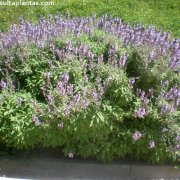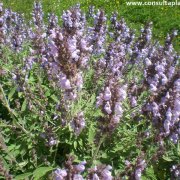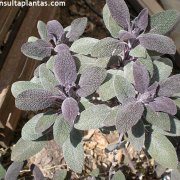Care of the shrub Salvia officinalis or Sage |
|
The genus Salvia, family Lamiaceae, comprises 1,000 species of shrubs and herbaceous plants native to Asia, Africa, the Mediterranean region, and Central and South America. Some species are: Salvia officinalis, Salvia splendens, Salvia scabra, Salvia nemorosa, Salvia namaensis, Salvia microphylla, Salvia mexicana, Salvia mellifera, Salvia leucantha, Salvia lanceolata, Salvia guaranitica, Salvia greggii, Salvia farinacea, Salvia disermas, Salvia canariensis, Salvia aurea, Salvia apiana, Salvia africana, Salvia vaseyi, Salvia leucophylla, Salvia verbenacea, Salvia sclarea, Salvia fruticosa, Salvia elegans, Salvia x sylvestris. Common names: Sage, Garden Sage, Common Sage, Culinary Sage. This species is native to Southern Europe. They are compact evergreen shrubs that reach 80 cm (2.62 feet) in height. The leaves are aromatic, elongated, greyish green in color and have a velvety texture. The showy purplish-blue flowers appear in spikes above the leaves. They bloom in spring and summer. Common Sage is used in borders, in rockeries, to cover dry slopes and in pots for balconies, terraces and patios. It's ideal for Mediterranean coastal gardens. The leaves are used as a condiment in cooking. Salvia officinalis needs full sun or light shade exposure. It resists occasional frosts but does not like intense heat. Garden Sage grows in any type of well-drained soil, even poor soils. Planting is done in early spring at the rate of 3 plants per square meter. Water moderately throughout the year waiting for the substrate to dry. They are sensitive to excess humidity and very resistant to drought. Culinary Sage does not need fertilizers. Prune off wilted flower spikes. Sage accepts intense pruning in late winter to strengthen the plant. Salvia officinalis can be attacked by aphids, snails, slugs, and mites. Common Sage is propagated by cuttings in early fall. |
Images of the shrub Salvia officinalis or Sage |
Find plants
Salvia officinalis or Sage | Care and Growing
© 2026 FavThemes





